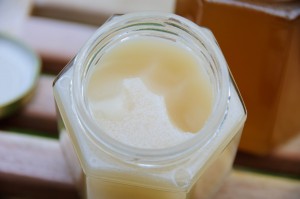Honey from rapeseed (canola)
Honey from rapeseed has many advantages but, for beekeepers, it is tricky to process. In this article I am trying to balance the various perspectives: For the consumer
Appearance: The honey is an opaque pale buff/cream colour which is lighter than the supermarket style set honey. (LEFT:light coloured jar next to our darker autumn honey)
Texture: it is a firm honey but not too hard to spread. It is also a very fine creamy smooth texture as the sugar crystals are very small.
Taste: it is a mild honey (this varies slightly according to the variety or rapeseed and also what else might be mixed into it) with a very slight but pleasant peppery aftertaste.
For the Beekeeper
Rapeseed is a mixed blessing as the bees can produce quite large quantities of honey in May and June (and this year - 2011 - even in April). Its always good to have a plentiful source of nectar and pollen to promote healthy productive bee colonies and even better to get lots of honey.
But....and its a big 'but'....beekeepers have to keep a close eye on the honey being produced when it contains rapeseed as it crystalises so readily it will set in the frames making extraction almost impossible. Most beekeepers empty any capped or half-capped frames at the end of May but if the temperature in the hive drops below 30 degrees the honey can begin to set within 24 hours. The reasons why the temperature might drop are:
- reduction in bee numbers keeping the frames warm - possibly because they have swarmed
- a very cold night reducing the temperature at the top of the hive further from the brood box heat
- the honey is fully capped so the bees leave it alone to cool as their work is done
You can tell if it is beginning to set by scraping the cappings off a small area of honey cells. If you see that the honey is some of the cells is opaque, its setting. Once it has begun to set there is no stopping it and the race is then on to remove the honey as quickly as possible.
Once extracted, it will set completely in the jars within a few weeks. If you want to keep it clear you need to pasteurise it by heating gently to about 50 degrees centigrade.
For the bees
Rapeseed is great for both nectar and pollen and therefore really boosts brood production. They will fill any free areas with pollen - sometimes more than they need taking up space that would otherwise be used for laying.
The colony can be so boosted that risk of swarming is much greater so weekly checks for queen cells will be vital from the first sign of rape flowers in the fields.
